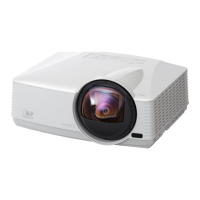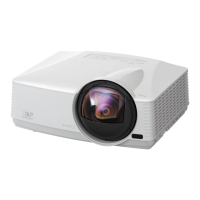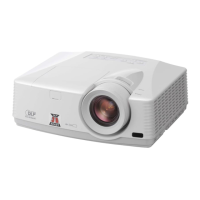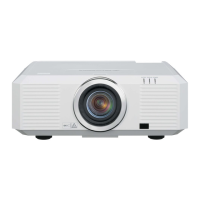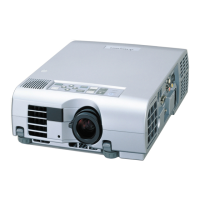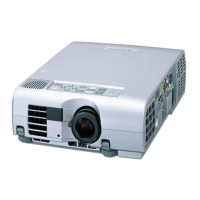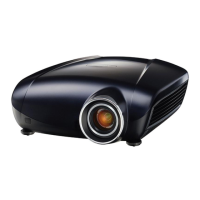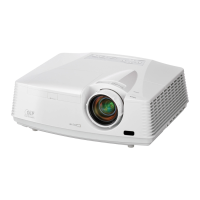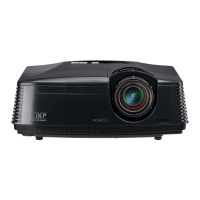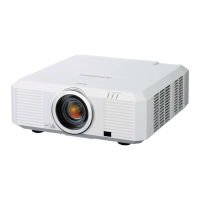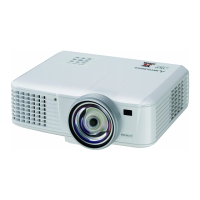How to remove noise around the image on Mitsubishi Projector?
- TTyler PriceSep 13, 2025
If noise appears around the image on your Mitsubishi Projector, especially with DVDs, decrease the setting value of OVER SCAN in the SIGNAL menu.
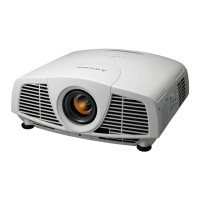
How to remove noise around the image on Mitsubishi Projector?
If noise appears around the image on your Mitsubishi Projector, especially with DVDs, decrease the setting value of OVER SCAN in the SIGNAL menu.
| Projection distance | - m |
|---|---|
| Vertical scan range | 50 - 95 Hz |
| Horizontal scan range | 15 - 100 kHz |
| Projection technology | DLP |
| Contrast ratio (typical) | 2300:1 |
| Screen size compatibility | 300 \ |
| Projector native resolution | WXGA (1280x800) |
| Video in | Yes |
| Resolution | 1280 x 1024 pixels |
| Aspect ratio | 4:3, 16:9 |
| RS-232 ports | 1 |
| Compatibility | PC Mac |
| Power supply type | AC |
| Dimensions (WxDxH) | 450 x 373 x 188 mm |
| Power requirements | 100 - 240 V, 50 - 60 Hz |
| Connectivity technology | Wired |
| Focus | Auto |
| Focal length range | - mm |
| Service life of light source | 4000 h |
| Noise level | 26 dB |
| Dot clock scanning frequency | 162 MHz |
| Analog signal format system | NTSC, PAL, SECAM |
| RMS rated power | 10 W |
| Headphone outputs | 2 |
| Serial interface type | RS-232 |
| USB 2.0 ports quantity | USB 2.0 ports have a data transmission speed of 480 Mbps, and are backwards compatible with USB 1.1 ports. You can connect all kinds of peripheral devices to them. |
| Wi-Fi | No |
| Power consumption (standby) | - W |
| Power consumption (typical) | 430 W |
| Weight | 10300 g |
|---|
Read all instructions, retain for future reference, and follow all warnings.
Precautions regarding cleaning, attachments, water exposure, and ventilation.
Guidelines for power sources, cord protection, overloading, and servicing by qualified personnel.
Conditions requiring service and using correct replacement parts.
Safe installation spots, avoiding extreme temperatures, humidity, and magnetic fields.
Warnings about direct lens viewing, hot surfaces, and finger insertion.
Verifying all included accessories like cables and remote control are present.
Proper procedure for inserting batteries into the remote control.
Instructions on how to remove batteries from the remote control.
Identification of projector components, control panel, and terminal layout.
Detailed descriptions of all input and output terminals on the projector.
Illustration of the projector's bottom side.
Detailed labeling of all buttons on the remote control.
Precautions and guidelines for operating the projector's laser beam.
Optimal distance, angles, and environmental factors for remote operation.
Connecting and operating the projector using a wired remote control cable.
Guidelines for perpendicular screen installation and projector positioning.
Charts correlating screen sizes with projection distances and lens shift adjustments.
Using lens shift controls to fine-tune image placement.
Tilting the projector and using keystone correction for image shape.
Specific installation procedures for ceiling and rear projection setups.
Detailed steps for connecting computers via analog (RGB, BNC) and digital (DVI) interfaces.
Connecting external monitors and audio equipment to the projector.
Explanation of the DDC standard for projector information exchange.
Instructions for safely plugging in the power cord, including grounding.
Procedure for fitting and securing the projector's terminal cover.
Step-by-step guide for powering on, selecting input, and adjusting image parameters.
Proper shutdown procedures and lamp cooling.
Using the instant shut down function for quick power off.
Using AV mute for temporary muting and auto position for image alignment.
Tips for notebook connections and adjusting screen resolution.
Adjusting the image aspect ratio to match different screen types and signals.
Guides for connecting video players, VCRs, and tuners using various cables.
Connecting DVD players and HDTVs via component, HDMI, or DVI-D.
Using HDMI and DVI-D terminals for high-quality video and audio input.
Specific adjustments for DVI-D input, including black level and sync settings.
Power connection and terminal cover installation for video sources.
Steps for powering on, selecting video input, and adjusting image parameters.
Adjusting speaker volume and setting aspect ratio for video signals.
Overview of QUICK MENU and DETAIL MENU display modes.
Description of frequently used settings in the QUICK MENU.
Overview of the five detailed menus available for configuration.
How to access, select, and adjust items within the menus.
Steps to change from QUICK MENU to DETAIL MENU mode.
Detailed explanation of each setting within the QUICK MENU.
Description of information items displayed in the INFORMATION menu.
Adjusting image parameters like color, brightness, contrast, and sharpness.
Configuration for lamp mode, standby, splash screen, and other installation options.
Settings for aspect ratio, password, cinema mode, video signal, and language.
Adjustments for resolution, position, frequency, sync, and noise reduction.
Modifying image brightness and contrast levels using menu options.
Adjusting color intensity and hue balance for optimal color reproduction.
Fine-tuning the sharpness of the projected image for clarity.
Selecting preset color temperatures or customizing white balance.
Explanation of color temperature and its effect on white appearance.
Adjusting color enhancer settings, gamma modes, and color parameters.
A step-by-step guide to resolve computer image projection issues.
Using menu options to fix common computer image display problems.
Methods for horizontally and vertically aligning the projected image.
Enabling the LPF to reduce streak noise in video signals.
Setting custom images for startup screens or during mute/no signal states.
Temporarily stopping and resuming the projected image motion.
Setting up password lock for operation, menu access, and splash screen.
Using the remote control as a mouse for computer operation via USB.
Supervising and controlling the projector via LAN using ProjectorView and PJLink™™.
Understanding the POWER and STATUS lights during normal projector operation.
Diagnosing problems using indicator status and suggested solutions.
Information on lamp lifespan, replacement indicators, and safety precautions.
Step-by-step guide for safely removing and installing the projector lamp.
Procedure to reset the lamp operation timer after replacement.
Specific instructions for removing the lamp from a ceiling-mounted projector.
Methods for cleaning the projector body, grilles, and ventilation slots.
Proper techniques for cleaning the projector lens safely and effectively.
Solutions for projector not powering on or no image appearing on screen.
Troubleshooting power turn-off, status indicators, and password screen issues.
Solutions for issues like image shaking, displacement, distortion, and darkness.
Addressing color tint, motion display, noise, and audio output issues.
Solutions for issues occurring after lamp replacement.
Information regarding the Kensington Security Standard connector.
A table detailing supported RGB signal modes, resolutions, and frequencies.
Pinout details for serial, DVI, HDMI, and other projector connectors.
